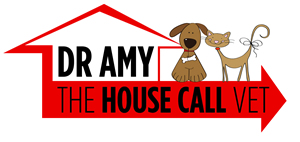Low Stress Handling Part 1 - introduction May 31, 2015 15:47
We see so many dogs and cats that are scared of vets. Some are even too scared to go in to the surgery anymore. Some are timid generally. Others have had traumatic experiences that have resulted in severe anxiety and even terror. So housecalls are a great option for these pets. And we don’t mind taking a little more time and being gentle and careful with these little ones that have had a rough time somewhere.

It’s not necessarily the vet’s fault of course! Just think – every time we see a pet, we have to “do things” to them – thermometer, otoscope, injections. Someone has to do these things. And these pets aren’t dumb – they remember! And the association builds in their minds over the years – this place/person is connected with discomfort, anxiety, occasional pain.
However there are some pets who just love the vet. They run to me, tail wagging, expecting a treat and waiting for some pats. They take the (small) vaccination sting in their stride (we are very gentle!). They trust me. What makes the difference?

Undoubtedly, the exposure they have during their baby months is paramount. Click on this link:
Puppies and Kittens: Keep them safe at home or take them out and show them off
to read my article about this crucial learning period, to understand how this can impact your pet for the rest of their life. (Especially if you have, or are soon to acquire, a puppy or kitten).
But each and every interaction continues to teach them what to expect. If they are anxious or afraid, and something negative does occur, then they are proved right – and will be even more afraid next time. Conversely, if we make the visit pleasant and enjoyable, and end on a trusting and positive note, they will be more likely to overlook any minor discomfort that occurred midway through the visit. They will then be able to maintain a positive impression of the whole experience.

So the difficult question is: how do I make a veterinary visit pleasant and enjoyable, while still achieving the health care required? This is NOT a simple or easy thing to do.
It starts with being able to recognise the very subtle earliest signs of fear or anxiety that are usually missed or ignored, and adjusting our handling and treatment at that time. It continues on with top notch animal handling and control skills that inspire confidence and promote relaxation in our patients. It also relies on identifying positive reinforcement options that are effective and available in each individual scenario, for each pet.
Dr Emma and I worked together earlier this year to complete a fantastically interesting course on low stress handling of dogs and cats. Dr Sophia Yin, a veterinary behavioural specialist, had put this course together as part of her work promoting force-free and positive reinforcement training and handling of pets.

We were both very excited to learn her techniques and methods (sometimes in excruciating detail)! And we are enjoying being able to use our new skills to help us keep our patients as happy, trusting and relaxed as possible. We also learned a great deal about helping pets who are already fearful or traumatised to overcome their fears and build a new trusting relationship.
It’s a big topic – we are still adjusting our habits, educating pet owners, reassessing priorities that have been taken for granted in the veterinary world for decades. This will be the first of a series of blog posts that will cover different aspects of the patient-vet-owner relationship. I hope you will enjoy learning about it as much as we did!
Dr Amy Coles
